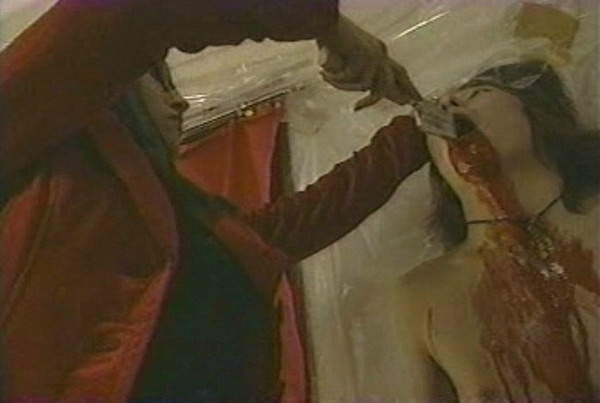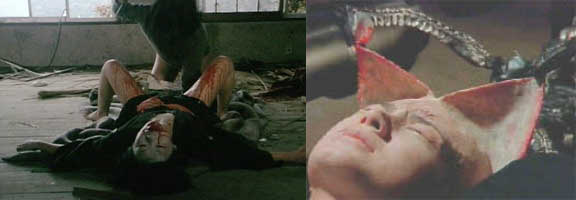

J-Horror Ghouls
“How does it feel to kill people?” (Mai Hosho,
“Tomie: Replay”)
Prominent pre-“Ringu” horror titles that foregrounded
girls and women as victims included “Hausu” ("House," 1977), and “Shiryo
no wana” (“Evil Dead Trap,” 1988) and its sequels. Other, egregiously
misogynist works of the late 1980s such as the “Za ginipiggu” (“Guinea
Pig”) films established a context of butchery that culminated in the “Ooru
naito rongu” (“All Night Long”) series of the 1990s.
 There is a Japanese term “ero-guro” (“eroguronansensu”)
describing films and other media (particularly manga) that involve absurd
– and often grotesque – erotica. Influential films of this sort that
arguably fall within the horror genre have included many bizarrely violent
titles dating from Koji Wakamatsu’s work in the late 1960s that was apparently
influenced by notorious American crime cases, culminating in the Japanese
Underground cyberpunk cinema of the 1990s. Films such as Kei Fujiwara’s
gory “Organ” (1996) or Shojin Fukui’s “964 Pinocchio” (aka “Screams of
Blasphemy,” 1991) and “Rubber’s Lover” (1997) involve violent deconstruction
of the human being – both metaphoric and literal. Katsuyu Matsumura’s
“All Night Long” trilogy dating from 1992 embodies a nihilistic esthetic
of pure destruction. These ghastly films foreground misogynist violence
that objectifies to the extent of literally equating women with garbage.
There is a Japanese term “ero-guro” (“eroguronansensu”)
describing films and other media (particularly manga) that involve absurd
– and often grotesque – erotica. Influential films of this sort that
arguably fall within the horror genre have included many bizarrely violent
titles dating from Koji Wakamatsu’s work in the late 1960s that was apparently
influenced by notorious American crime cases, culminating in the Japanese
Underground cyberpunk cinema of the 1990s. Films such as Kei Fujiwara’s
gory “Organ” (1996) or Shojin Fukui’s “964 Pinocchio” (aka “Screams of
Blasphemy,” 1991) and “Rubber’s Lover” (1997) involve violent deconstruction
of the human being – both metaphoric and literal. Katsuyu Matsumura’s
“All Night Long” trilogy dating from 1992 embodies a nihilistic esthetic
of pure destruction. These ghastly films foreground misogynist violence
that objectifies to the extent of literally equating women with garbage.
 The exploitation films of directors such as Daisuke
Yamanouchi (“Akai misshitsu heya: Kindan no osama geemu,” aka “Red
Room,” 1999; “Shojo jigoku ichi kyuu kyuu kyuu” aka “Girl Hell,” 1999;
“Senketsu no Kuzuna: Kichiku reipuhan o shinkan saseta shimai” aka
“Blood Sisters,” 2000; “Kyoko vs. Yuki,” 2000), Tamakichi Anaru (“Niku
daruma” aka “Tumbling Doll of Flesh,” 1998; “Satsu satsu ayame” aka “Suicide
Dolls,” 1999; “Watashi no akai harawata hana” aka “Women’s Flesh,” 1999),
Hisayasu Sato’s “Megyaku” (“Naked Blood,” 1995), Naoyuki Tomomatsu’s “Kogayaru-gui:
Oosaka terekura hen” (“Eat the Schoolgirl,” 1997) as well as Yuuri Sunohara’s
“Zankoku-bi: Onna harakiri” series (from 1990) or Izô Hashimoto’s
“Shiroi kabe no kekkon” (“Guinea Pig: Lucky Sky Diamond,” aka “Bloody
Fragments on White Walls,” 1989) display themes of quasi-snuff dismemberment
most notoriously associated with the “Guinea Pig” films. Such titles
represent the very antithesis of those given precedence in this essay and
may serve (together with numerous other “pinku” exploitation titles fusing
sex with violence toward women) as utterly negative examples of relevant
genre themes that are horrifying displays of sadistic male domination and
literal destruction of the female body. One need look no further
for more graphic support of film theory constructions of the sadistic patriarchal
gaze.
The exploitation films of directors such as Daisuke
Yamanouchi (“Akai misshitsu heya: Kindan no osama geemu,” aka “Red
Room,” 1999; “Shojo jigoku ichi kyuu kyuu kyuu” aka “Girl Hell,” 1999;
“Senketsu no Kuzuna: Kichiku reipuhan o shinkan saseta shimai” aka
“Blood Sisters,” 2000; “Kyoko vs. Yuki,” 2000), Tamakichi Anaru (“Niku
daruma” aka “Tumbling Doll of Flesh,” 1998; “Satsu satsu ayame” aka “Suicide
Dolls,” 1999; “Watashi no akai harawata hana” aka “Women’s Flesh,” 1999),
Hisayasu Sato’s “Megyaku” (“Naked Blood,” 1995), Naoyuki Tomomatsu’s “Kogayaru-gui:
Oosaka terekura hen” (“Eat the Schoolgirl,” 1997) as well as Yuuri Sunohara’s
“Zankoku-bi: Onna harakiri” series (from 1990) or Izô Hashimoto’s
“Shiroi kabe no kekkon” (“Guinea Pig: Lucky Sky Diamond,” aka “Bloody
Fragments on White Walls,” 1989) display themes of quasi-snuff dismemberment
most notoriously associated with the “Guinea Pig” films. Such titles
represent the very antithesis of those given precedence in this essay and
may serve (together with numerous other “pinku” exploitation titles fusing
sex with violence toward women) as utterly negative examples of relevant
genre themes that are horrifying displays of sadistic male domination and
literal destruction of the female body. One need look no further
for more graphic support of film theory constructions of the sadistic patriarchal
gaze.
 Bizarre acts of bodily destruction continue in
titles such as Kenichi Yoshihara’s “Senrei” (“Baptism of Blood,” 1996),
Kazuyoshi Kumakiri’s “Kichiku dai enkai” (“Banquet of the Beasts,” 1997)
and Shugo Fujii’s “Iki-jigoku” (“Living Hell,” 2000), but are noteworthy
in that their extremes of suffering are inflicted by women as well as on
women. Takahisa Zeze’s “Raigyo” (“The Woman in Black Underwear: Raigyo,”
1997) employs pervasive violence against the environment as the mise-en-scene
for horrific counter-violence by the female protagonist. A more thoughtful
treatment of the symbolism of dismemberment, personal fragmentation and
the shifting nature of personal relations is provided by Shinji Aoyama’s
excellent “Enbamingu” (“EM Embalming,” 1999) in which Reiko Takashima plays
an embalmer who embarks on a dangerous private investigation after a multiple-personality-disordered
young woman (with Hitomi Miwa suitably cast in the role) mysteriously steals
the head of a corpse. The dangerously ephemeral and culturally constructed
nature of female physical beauty receives horrific deconstruction in Katsuya
Matsumura’s “Kirei?” (“The Terror of Beauty,” 2004) in which Yukiko Okamoto
plays “Dr. Yôko Noguchi,” a narcissistically self-satisfied plastic
surgeon who meets the female patient of her nightmares – a woman who not
only desires to become as beautiful as her, but also possess all that she
has! Regrettably, the opportunity to critique attractiveness stereotypes
is dissipated in an exercise that defines women’s desires by reference
to patriarchal norms.
Bizarre acts of bodily destruction continue in
titles such as Kenichi Yoshihara’s “Senrei” (“Baptism of Blood,” 1996),
Kazuyoshi Kumakiri’s “Kichiku dai enkai” (“Banquet of the Beasts,” 1997)
and Shugo Fujii’s “Iki-jigoku” (“Living Hell,” 2000), but are noteworthy
in that their extremes of suffering are inflicted by women as well as on
women. Takahisa Zeze’s “Raigyo” (“The Woman in Black Underwear: Raigyo,”
1997) employs pervasive violence against the environment as the mise-en-scene
for horrific counter-violence by the female protagonist. A more thoughtful
treatment of the symbolism of dismemberment, personal fragmentation and
the shifting nature of personal relations is provided by Shinji Aoyama’s
excellent “Enbamingu” (“EM Embalming,” 1999) in which Reiko Takashima plays
an embalmer who embarks on a dangerous private investigation after a multiple-personality-disordered
young woman (with Hitomi Miwa suitably cast in the role) mysteriously steals
the head of a corpse. The dangerously ephemeral and culturally constructed
nature of female physical beauty receives horrific deconstruction in Katsuya
Matsumura’s “Kirei?” (“The Terror of Beauty,” 2004) in which Yukiko Okamoto
plays “Dr. Yôko Noguchi,” a narcissistically self-satisfied plastic
surgeon who meets the female patient of her nightmares – a woman who not
only desires to become as beautiful as her, but also possess all that she
has! Regrettably, the opportunity to critique attractiveness stereotypes
is dissipated in an exercise that defines women’s desires by reference
to patriarchal norms.







